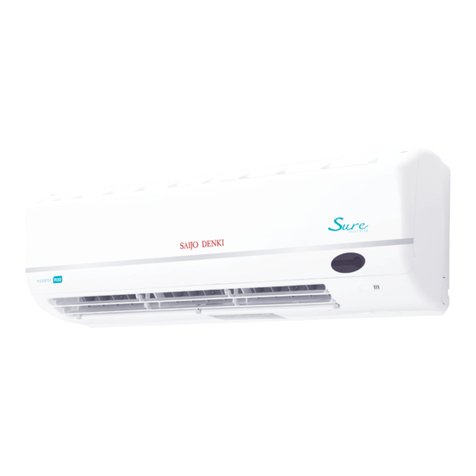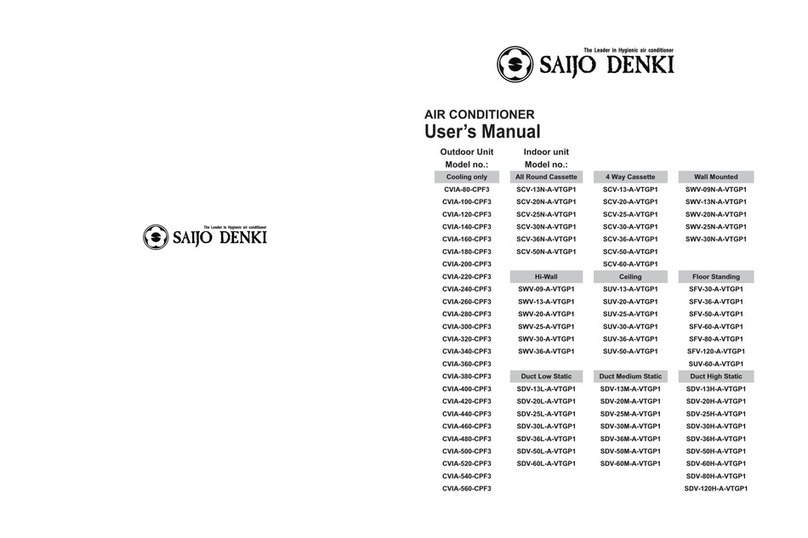
Do
not operate the
unit with the
valve closed.
Saijo denki International co.,ltd. 9
Check after
reinstallation
Only a qualified installer (*1) or qualified service person (*1) is allowed to relocate the air conditioner. It is
dangerous for the air conditioner to be relocated by an unqualified individual since a fire, electric shocks,
injury, water leakage, noise and/or vibration may result.
Check the following items after reinstallation.
1) The earth wire is correctly connected.
2) The power cord is not caught in the product.
3) There is no inclination or unsteadiness and the installation is stable.
If check is not executed, a fire, an electric shock or an injury is caused.
When carrying out the pump-down work shut down the compressor before disconnecting the refrigerant
pipe. Disconnecting the refrigerant pipe with the service valve left open and the compressor still
operating will cause air, etc. to be sucked in, raising the pressure inside the refrigeration cycle to an
abnormally high level, and possibly resulting in reputing, injury, etc.
When the service panel of the outdoor unit is to be opened in order for the compressor or the area
around this part to be repaired immediately after the air conditioner has been shut down, set the circuit
breaker to the OFF position, and then wait at least 10 minutes before opening the service panel.
If you fail to heed this warning, you will run the risk of burning yourself because the compressor pipes
and other parts will be very hot to the touch. In addition, before proceeding with the repair work, wear the
kind of insulated heat-resistant gloves designed to protect electricians.
Take care not to get burned by compressor pipes or other parts when checking the cooling cycle while
running the unit as they get heated while running. Be sure to put on gloves providing protection for
electric shock and heat.
When the service panel of the outdoor unit is to be opened in order for the fan motor, reactor, inverter or
the areas around these parts to be repaired immediately after the air conditioner has been shut down,
set the circuit breaker to the OFF position, and then wait at least 10 minutes before opening the service
panel.
If you fail to heed this warning, you will run the risk of burning yourself because the fan motor,
reactor, inverter heat sink and other parts will be very hot to the touch. In addition, before proceeding
with the repair work, wear the kind of insulated heat-resistant gloves designed to protect electricians.
Once the repair work has been completed, check for refrigerant leaks, and check the insulation
resistance and water drainage.
Then perform a trial run to check that the air conditioner is running properly.
After repair work has finished, check there is no trouble. If check is not executed, a fire, electric shock or
injury may be caused. For a check, turn off the power breaker.
After repair work (installation of front panel and cabinet) has finished, execute a test run to check there is
no generation of smoke or abnormal sound.
If check is not executed, a fire or an electric shock is caused. Before test run, install the front panel
and cabinet.
Be sure to fix the screws back which have been removed for installation or other purposes.
Check the following matters before a test run after repairing piping.
• Connect the pipes surely and there is no leak of refrigerant.
• The valve is opened.
Running the compressor under condition that the valve closes causes an abnormal
high pressure resulted in damage of the parts of the compressor and etc. and moreover if there is leak of
refrigerant at connecting section of pipes, the air is sucked and causes further abnormal high pressure
resulted in burst or injury.





























